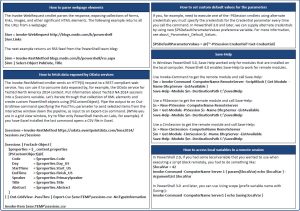Hi Guys today will just share some useful tips and tricks!
Just save the IMG to check it out, or check it below .
Enjoy

How to Scheule a job
Job scheduling allows you to schedule execution of a PowerShell background job for a later time. The first thing you do is create a job trigger. This defines when the job will execute. Then you use the Register-ScheduledJob cmdlet to actually register the job on the system. In the following example, every day at 3 am we back up your important files:
$trigger = New-JobTrigger -Daily -At 3am
Register-ScheduledJob -Name DailyBackup -Trigger $trigger -ScriptBlock {Copy-Item c:\ImportantFiles d:\Backup$((Get-Date).ToFileTime()) -Recurse -Force -PassThru}
Once the trigger has fired and the job has run, you can work with it the same way you do with regular background jobs:
Get-Job -Name DailyBackup | Receive-Job
You can start a scheduled job manually, rather than waiting for the trigger to fire:
Start-Job -DefinitionName DailyBackup
The RunNow parameter for Register-ScheduledJob and Set-ScheduledJob eliminates the need to set an immediate start date and time for jobs by using the -Trigger parameter:
Register-ScheduledJob -Name Backup -ScriptBlock {Copy-Item c:\ImportantFiles d:\Backup$((Get-Date).ToFileTime()) -Recurse -Force -PassThru} -RunNow
How to generate complex password
There is no built-in cmdlet to generate a password, but we can leverage a vast number of .NET Framework classes. System.Web.Security.Membership class has a static method GeneratePassword(). First, we need to load an assembly containing this class, and then we use GeneratePassword() to define password length and a number of non-alphanumeric characters.
$Assembly = Add-Type -AssemblyName System.Web
[System.Web.Security.Membership]::GeneratePassword(8,3)
How do we know all that? With a little help from the Get-Member cmdlet (and simplified where syntax):
[System.Web.Security.Membership] | Get-Member -MemberType method -Static| where name -match password
Dynamic method invocation
Windows PowerShell 4.0 supports method invocation using dynamic method names.
$fn = "ToString"
"Hello".ToString()
"Hello".$fn()
"Hello".("To" + "String")()
#Select a method from an array:
$index = 1; "Hello".(@("ToUpper", "ToLower")[$index])()



0 Comments